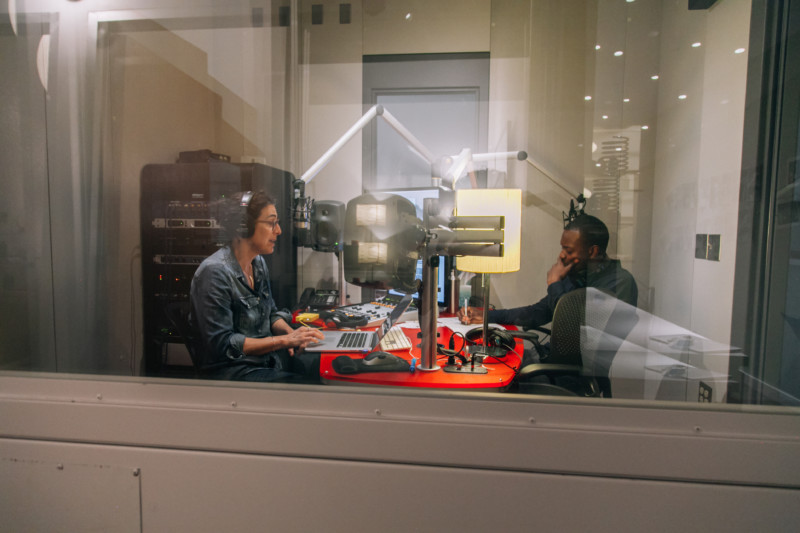Sign up for the daily CJR newsletter.
At the top of the transcripts page for the third season of Serial, a favorite on numerous year-end podcast lists, is a warning: “Serial is produced for the ear and designed to be heard, not read.”
We read the transcripts anyway. And we discovered that while Serial is a podcast, reporter Sarah Koenig’s bold writing in the latest season, which follows a year in a Cleveland courthouse, offers valuable lessons for print journalists.
From the archives: Serial, Mystery Show, and why listeners want to be in on the investigation
Koenig is not constrained by the clunky traditions of print journalism—the apparatus of attribution and the awkward third-person-ness that many news organizations require. Instead, she brings us along as she figures out the story, and candidly details what she finds, what she likes and doesn’t like, and when she’s confused.
She’s writing for a listener, not a reader, and the approach for radio and podcasts has always been less formal. (Some magazines, of course, have long embraced the wide-open style she employs.) Still, her style offers valuable lessons for all kinds of writers.
Avoid a bucket of quotes
“This place is primarily black and white,” Koenig says in her masterful introduction, which describes people in an elevator as a microcosm of the Cleveland Justice Center:
“The majority of the courthouse staff is black. Clerks are mostly black. Most of their managers are white. In the sheriff’s department, most of the security guards are black. Most of the deputies are white. Most of the attorneys are white. Almost all the county judges are white, and their bailiffs are white. Most of the defendants and crime victims are black.
“In the cocoon of the elevator, everyone’s polite to each other (and) pretends nothing is weird about this.”
Rather than recite a bunch of clinical statistics, she just sums up what she saw. Her elevator riff about skin color sets up the central conflict of the entire series: the racial divide of the American justice system.
Koenig and Emmanuel Dzotsi, a producer who also spent months at the courthouse, are at their best when they distill their weeks of reporting into trenchant observations. They don’t burden us with long quotes and force us draw our own conclusions. They’re comfortable being the experts.
In newspaper and magazine writing, even the best reporters sometimes have a tendency to turn their stories into a bucket of quotes. They’ll copy and paste quotes from one expert after another and feel they’ve done a sufficient job serving the reader. But that makes it difficult to know what’s important. Koenig understands the importance of economy. She doesn’t make us wade through a junkyard of attribution. She just sums up what she saw and heard.
Take her handling of academic studies on race. In the hands of an ordinary reporter, they would make for some pretty humdrum paragraphs. But Koenig’s summary of the studies is tight and practically poetic:
“Every joint in the skeleton of our criminal justice system is greased by racial discrimination. Compared to white people who’ve committed the same crime and who have similar criminal histories, black people and other people of color are arrested more often. They’re charged more harshly, given higher bails, offered worse plea deals. They’re handed longer prison sentences, and their probation is more often revoked.”
She pulls off the same feat with her observations about people who have a criminal record, which she describes as “the stink”:
“So Anna’s not clean. Not that there are a lot of clean records in the Justice Center. Most of the defendants, many of the victims, too, have had some prior entanglement with the law. And even if it’s small stuff—marijuana possession or trespassing—you get the stink on you, or what I’ve come to think of as the stink. You get a whiff of bad citizenry about you. An odor that causes the presumption of innocence to shrivel.”
Many reporters are afraid to draw that kind of strong conclusion. They’d rather hide behind someone else’s quote. But Koenig has spent enough time in the courthouse to be confident in her reporting and isn’t afraid to sum up her findings.
Bring the readers along
When a journalist starts a first draft, it’s as if they stop being a reporter and switch gears to being a writer. Their experiences from reporting fade away and never appear in the published piece.
Writers, particularly at newspapers, follow strict customs of attribution. Yet they often don’t reveal how they got their information.
In Serial, Koenig and Dzotsi bring us along as they do their reporting. We hear their questions, their opinions, and their confusion. Some moments reveal the spontaneity of interviews, such as when police suddenly show up while a man is telling Dzotsi how he was beaten by them.
Other scenes provide helpful transparency about the pair’s reporting. Early in the season, Koenig interviews a woman named Anna about a bar fight. By showing Koenig’s reaction, the back-and-forth reveals Anna’s character and gives her credibility.
Anna: So I go and get a drink, and this guy is smacking me on my rear end and—
Koenig: It was a guy you had been talking to or no?
Anna: No, just some random guy at the bar.
Koenig: Are you serious? It was a random guy? I figured you knew that guy.
Anna: No, I did not know him.
Koenig: Why is he just smacking your butt?
Anna: Because men are dogs. [She laughs.] They can be dogs. And at first I was like, haha, stop. And then he kept doing it, and I actually got mad and I got in his face.
Koenig isn’t afraid to reveal what she doesn’t know. Just as she did in the first season, which focused on a man who had a questionable murder conviction, she explains her doubts and questions her own reporting, which makes us trust her.
In episode 8 of the new season, Koenig admits that she’s having trouble believing that no one was raising any alarms when a boy named Joshua in a juvenile detention center was being mercilessly harassed by fellow inmates. “So I considered, as anyone in my position would, there’s probably more to this story that I’m not seeing,” she confesses. “I set out to fact-check Joshua.”
She then interviews a counselor who mentored Joshua in the juvenile detention center. The woman confirms everything. The scene gives us confidence in Koenig’s reporting because she’s shown us what she did.
Like any great writer, Koenig knows how to use vivid details to reveal her characters. In this passage, she describes how Anna dresses up for her trial on charges that she hit a police officer:
“Anna shows up for her trial wearing a new dress she got at Marshall’s, navy blue with white piping around the collar, cap sleeves, string of pearls, sparkly flats. She looks like an attorney, which she later told me was the look she was going for. She’ll leave the tags on the dress in hopes of returning it. The shoes, she’ll keep.”
Koenig writes like real people talk. Instead of telling us about “the defendant,” she describes “the cookie baker” facing a felony conviction for offering a marijuana cookie to an unknowing acquaintance. The man who assaulted a woman at a bar becomes the “ass slapper.”
She transforms her interviews into powerful prose. Introducing us to a man who lost his infant daughter in an accidental shooting, she says, “Charles is a big man, big and soft around the edges. His mother told me he was always a crier, but now the tears seemed to leak from him unbidden.”
Reporters are trained to stay above the fray and keep their opinions out of their writing. If they stuck to a narrative approach, the style would be ‘show, don’t tell.’ But Koenig, a former newspaper reporter, isn’t shackled by those stifling traditions.
It’s OK to have an opinion
If a newspaper published a year-in-a-courthouse series, it probably would have many of the same elements as Serial: compelling examples, heroes and villains. If it were published as a series, the final day would probably be called “solutions,” offering a laundry list of prescriptions to fix the ills of the American justice system.
But that traditional approach would lack the wallop that Koenig ultimately achieves. Newspaper journalists are often reluctant to put their own conclusions in their work—a style that reflects the long tradition of objectivity in American newspapers. Reporters are trained to stay above the fray and keep their opinions out of their writing. If they stuck to a narrative approach, the style would be “show, don’t tell.” They would lay out the details and let the reader figure it out.
But Koenig, a former newspaper reporter, isn’t shackled by those stifling traditions. Throughout the series, she lets us know what she thinks, acting as a helpful tour guide revealing the outrages and absurdities in the justice center.
She is candid in describing characters. “I like Russ,” she says of defense attorney Russ Bensing. “His colleagues like him, too. Not clear whether his clients like him. He can sometimes be a bit of an asshole to his clients, actually.”
One of her most important observations is that the court system is clueless about which punishments are most effective:
“This is possibly the most profound and least examined question in the building. What works? The court doesn’t gather statistics on sentencing, and that’s true for most of the country, by the way. No data that says defendants in Cuyahoga County do better after six months of probation than after three years of probation, or, in terms of re-offending, four years in prison yields better results than seven years in prison. We just don’t know.”
She calls this “rather astounding” and tells listeners the court is focused on tracking efficiency, not whether the system actually reduces crime and helps criminals stop being criminals. “There’s no database, locally or nationally, that shows what works,” she says. “So each judge in the building has to muddle it out for him or herself.”
Koenig sums up her year of reporting with a list of smart prescriptions informed by her work, including “Don’t lock anyone up unless they’re demonstrably violent” and “Get out of the punishment business and turn toward the urgent problem of fairness.” She would submit them through the suggestion box in the justice center lobby—could fill it ’til it bursts, she says—but would be happy for just one to make it through: “I’d say, let’s all accept that something’s gone wrong. Let’s make that our premise.” That muscular conclusion may strike some as bold, but it shouldn’t; it’s just the product of great reporting.
From the archives: This American Life listeners are sharing audio in unexpected ways
Has America ever needed a media defender more than now? Help us by joining CJR today.








